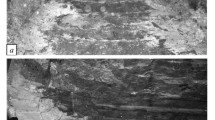We study the destruction of graphitized electrodes in the course of their operation. It is shown that the predicted behavior of an electrode column under thermal shocks guarantees the possibility of application of integrated performance characteristics of graphitized electrodes, including the thermal stability of the electrode material as a technological factor of production and the dependence of the admissible operating current on the quality criterion of the electrode column regarded as a structural element of the electric furnace as an operational factor.






Similar content being viewed by others
References
S. A. Kolesnikov,M. Yu. Bamborin, V. A. Vorontsov, et al., Formation of carbon-carbon composite material thermal conductivity standards, Refractories and Industrial Ceramics, 58(1), 94 – 102 (2017).
M. Yu. Babkin, Evaluation of the thermal stability of graphitized electrodes, in: Contemporary State and Prospects of the Development of Electrode Products and Structural and Composite Carbon Materials [in Russian], Èntsiklopediya, Chelyabinsk (2010), pp. 202 – 205.
W. D. Kingery, Factors affecting thermal stress resistance of ceramic materials, J. Am. Ceram. Soc., 38(1), 3 – 15 (1955).
GOST 7875.0–94. Refractory Products. Basic Requirements for Procedures of Thermal Shock Resistance Determination [in Russian], Izd. Standartov, Moscow (1995).
Yu. I. Barkov, N. V. Negutorov, and A. G. Pyatkovskii, AProcedure of Testing of Refractory Materials [in Russian], Inventor’s Certificate 442394 SSSR, Otkryt. Izobret. Promyshl. Obrazts. Tovarn. Znaki, No. 33 (1974).
E. V. Kalyadov, G. D. Apal’kova, N. V. Glushkov, I. S. Varypaev, and N. F. Kondrashenkova, A Procedure of Determination of the Thermal Stability of Refractory Materials [in Russian], Inventor’s Certificate 1188582 SSSR, Otkryt. Izobret. Promyshl. Obrazts. Tovarn. Znaki, No. 40 (1985).
G. D. Apal’kova, On the problem of thermal stability of materials used in the technological equipment of contemporary processes, in: Proc. of the 68th Sci. Conf. “Science at the South-Ural State Univ.” [in Russian], South Ural State University, Chelyabinsk (2016), pp. 465 – 471.
A. N. Seleznev, G. D. Apalkova, V. V. Ochkov, and V. I. Pirogov, “Thermal stability of advanced carbon bottom blocks for aluminum electrolysis cells,” Refractories and Industrial Ceramics, 46(4), 235 – 238 (2005).
G. Vergazova and G. Apalkova, A new approach to establishing thermal shock resistance of cathode blocks, TMS Light Metals, 945 – 949 (2006).
GOST R MÉK 60239–2014. Graphitized Electrodes for Electric- Arc Furnaces. Dimensions and Notation [in Russian], Introduced on 01.07.2015, Standartinform, Moscow (2014).
G. D. Apal’kova, A. G. Myannik, N. G. Tarynin, Z. K. Shafigin, B. I. Davydovich, and V. V. Mochalov, A Method for the Determination of Admissible Current for Graphitized Electrodes [in Russian], Patent of RF 2031552, No. 5060050/07; Submitted 25.08.92 ; Publ. on 20.03.95, Bull. No. 8.
C. R. Armstrong, T. L. Bosserman, K. E. Haibult, et al., Electrode consumption in a modem hing-power electric steel shop, Iron & Steel Technol., No. 1, 57 – 68 (2013).
A. G. Belkovskii, Measures used to decrease the consumption of electrodes at the steel plant of the SDI Company in Butler (report), Novosti Chern. Metallurg. Rubezh., No. 2, 23 – 26 (2013).
J. Borlée, M. Wauters, C. Mathy, and M. Weber, Monitoring System for Controlling and Reducing the Electrode Consumption in DC EAF Plants, Final report Directorate-General for Research, Contract No RFSR-CT-2003-00024, European Commission, Brussels (2009).
G. D. Apal’kova, On the problem of operation of electrodes in electric-arc furnaces under the contemporary conditions of the engineering industry, Èlectrometallurgiya, No. 5, 3 – 11 (2015).
DIN-Mitteilungen+elektronorm, No. 6, 3 – 6 (2003).
GOST R 56973–2016. Graphite Electrodes for Electric-Arc Furnaces. Exploitation [in Russian], Standartinform, Moscow (2016).
GOST R 57613–2017. Graphite Electrodes and Nipples. Specifications [in Russian], URL http://normacs.ru.
The present work was supported by the Government of the Russian Federation (Resolution No. 211 of 16.03.2013); Agreement No. 02.A03.21.0011.
Author information
Authors and Affiliations
Corresponding author
Additional information
Translated from Novye Ogneupory, No. 3, pp. 57 – 63, March, 2018.
Rights and permissions
About this article
Cite this article
Apal’kova, G.D. Destruction of Graphitized Electrodes Under the Conditions of Thermal Shock. Refract Ind Ceram 59, 163–169 (2018). https://doi.org/10.1007/s11148-018-0199-z
Received:
Published:
Issue Date:
DOI: https://doi.org/10.1007/s11148-018-0199-z




